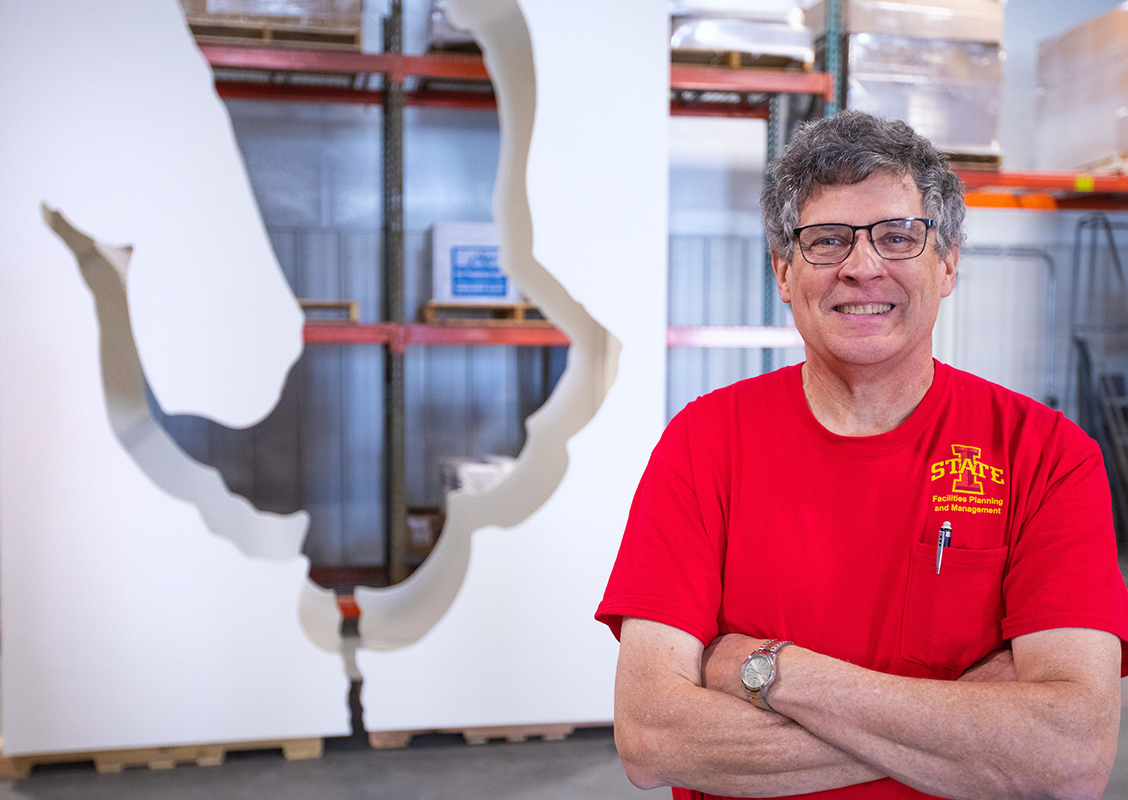An impactful way to celebrate soybeans
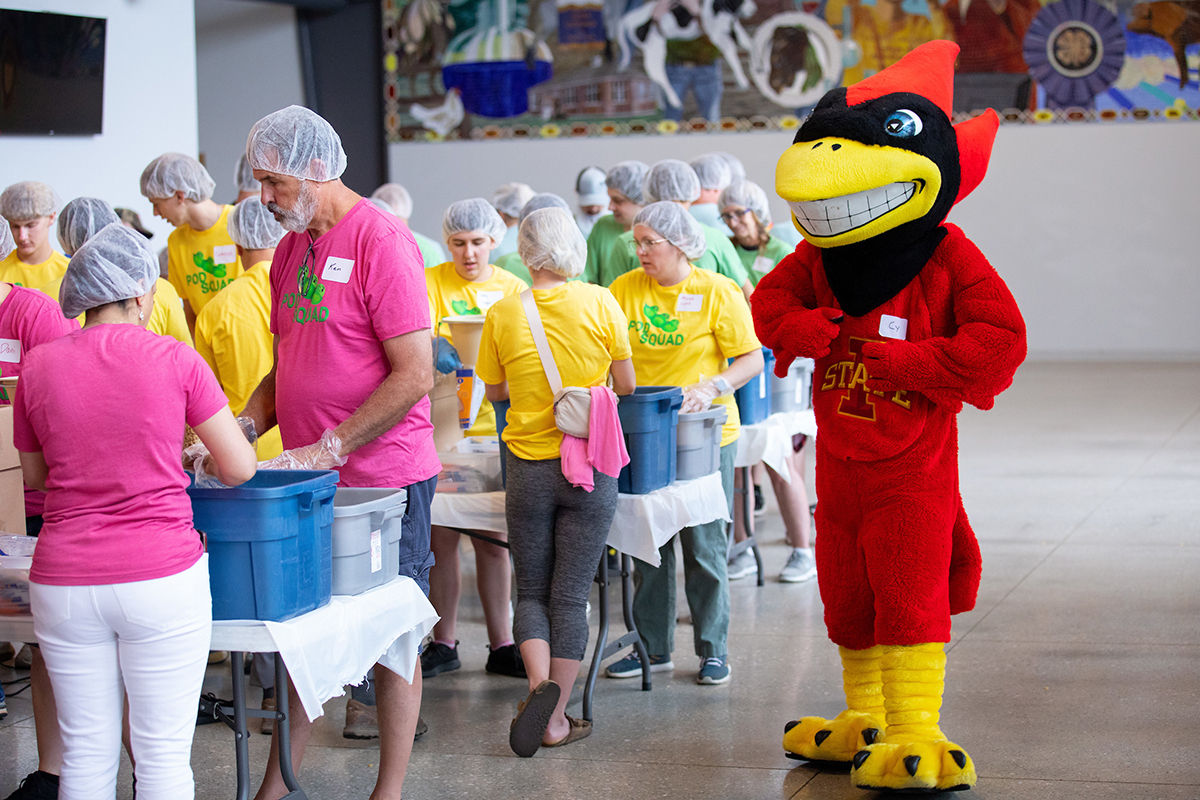
Volunteers wore team jerseys -- and Cy "officiated" -- at a Meals from the Heartland packaging event Wednesday afternoon at the Hansen Agriculture Student Learning Center. Staff at the Iowa Soybean Research Center organized the benefit event as part of its Soybean Month in Iowa celebration. Photos by Christopher Gannon.
The Iowa Soybean Research Center kicked off Soybean Month in Iowa by hosting a Meals from the Heartland food packaging event Aug. 2. More than 50 student, faculty and staff volunteers in color-coded team T-shirts -- many from the colleges of Agriculture and Life Sciences, Human Sciences and Engineering -- packaged 38,000 meals in two hours at the Hansen Agriculture Student Learning Center. It was the center's third annual event, all made possible by a Cargill donation to cover the cost of the ingredients for Taco Mac meals which includes soy protein flour, enriched pasta and a vitamin- and mineral-fortified cheese mix.
Some of the meals packaged at Wednesday's event -- about 2,500 -- will stay in Ames. They'll be delivered to the SHOP (Students Helping Our Peers) food pantry in Beyer Hall and Food at First at the First Christian Church downtown, which offers a daily hot meal and food stuffs for those in need. The rest will be distributed in the Des Moines area and, possibly, wherever a natural disaster has occurred recently.
Headquartered in West Des Moines, Meals from the Heartland relies on financial donations and volunteers from local organizations who package meals for delivery to malnourished people in Iowa, across the country and around the world. Last year, those meal distribution ratios were 3%, 13% and 84%, respectively.
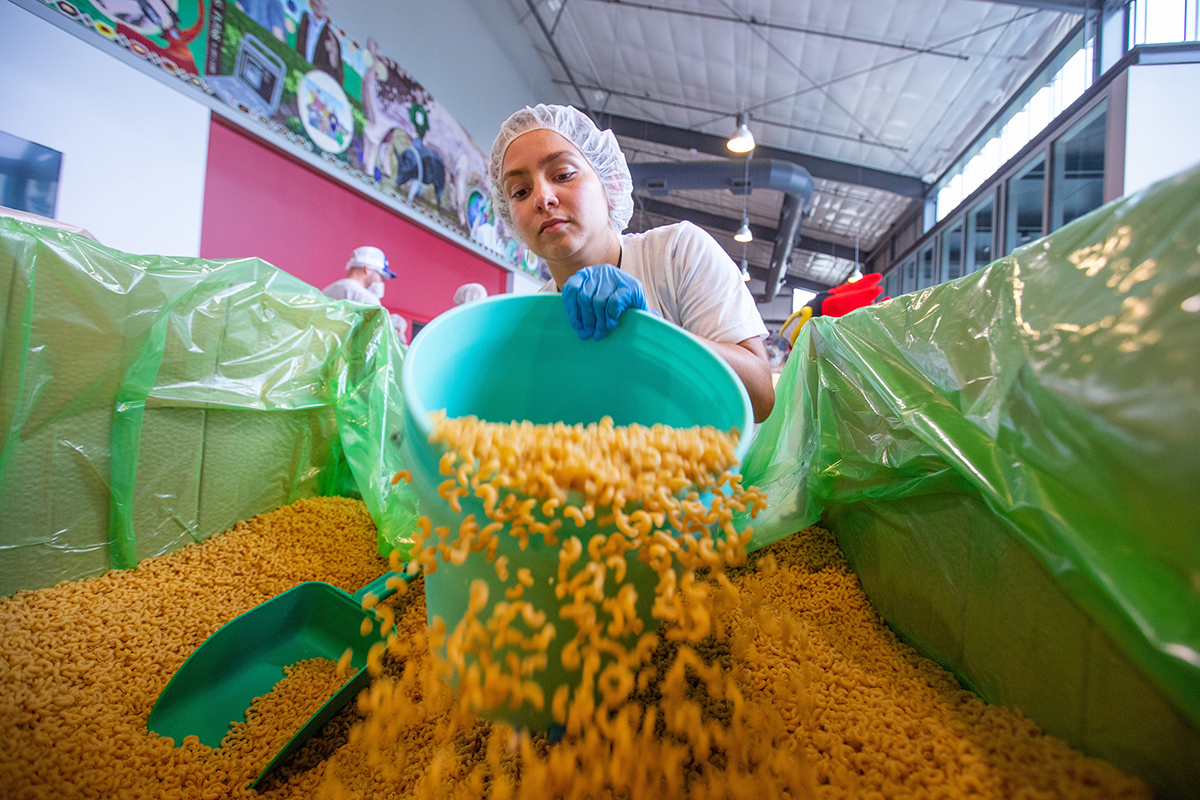
Plant pathology graduate student Sharon Badilla scoops up macaroni to refill packaging lines during a Meals from the Heartland packaging event Wednesday afternoon at the Hansen Agriculture Student Learning Center.
Digital accessibility tools prioritize inclusion
July 26 marked the 33rd anniversary of the Americans with Disabilities Act (ADA), a revolutionary civil rights law prohibiting discrimination based on disability. Awareness and action around accessibility have expanded in the years since the ADA was signed, most recently in the realm of digital accessibility as technological platforms and tools grow in popularity and use.
"Some people may have heard about digital accessibility but don't quite know how to connect it to what they're doing," said Cyndi Wiley, digital accessibility lead for Information Technology Services. "We encounter digital accessibility every day."
Resources for employees
Though digital accessibility and accommodations both involve disability, they are not the same. Accommodations are arranged with university human resources (UHR) and can include a modification to a job or work environment that ensures employees with disabilities can successfully perform their tasks. While utilizing assistive technology and prioritizing digital accessibility may be included in the accommodation process, the digital accessibility team focuses on providing tools and education at an enterprise level while working closely with campus partners to answer questions about available resources.
"Our team can be helpful with identifying tools, working with procurement and piloting programs," Wiley said. "We often collaborate and talk about what we have tested and what's included in software that people might not know about already."
The digital accessibility team also provides support and consultation for employees looking to make their course materials, websites and other digital media more accessible. The digital accessibility toolkit -- an online collection of easy-to-use accessibility tools and resources for faculty, staff and students -- can help departments improve the accessibility of their materials, request additional services and learn more about the importance of digital accessibility.
Wiley said they are always looking for new resources and partnerships -- like with fellow regent universities who worked with ISU on the request for proposal for a web accessibility checker -- to identify opportunities to bring more digital accessibility tools to the university.
Learn more
- Explore the digital accessibility toolkit
- Get started in Siteimprove
- Review the digital accessibility policy
- Join the Digital Accessibility at ISU Microsoft Teams group
Wiley said Siteimprove, the web accessibility checker software that launched in May 2021, has been invaluable as their team works to make digital accessibility more attainable for content managers across the university. Site owners and editors can add Siteimprove to their Sign On Dashboard and submit a request form to have their websites loaded into the system to be scanned. Some of Siteimprove’s capabilities include quality assurance for common accessibility errors like broken links, misspelled words and lack of alt text for images, and the platform can also evaluate search engine optimization and produce heat maps of user clicks.
Another helpful resource for faculty and students is Ally, a tool integrated directly into Canvas to improve the accessibility of digital course content. To help make course materials more accessible, Ally generates alternative formats and provides detailed instructor feedback on fixing accessibility issues
"If we aren't making things digitally accessible, not only are we leaving people out but we're also not in alignment with the strategic plan or living up to how the public views Iowa State," Wiley said. "We are innovative and part of innovation is being inclusive of as many people as possible in that process."
Innovation and inclusion are also the drivers behind the digital accessibility policy, a set of guidelines requiring all digital content and resources produced and purchased to be accessible. Wiley said after July 1, 2026, software that is not in compliance with the policy will no longer be purchased by the university.
"We are working to let people know if their software is currently compliant or non-compliant during the software review process since it will need to be before the deadline," Wiley said. "There are benchmarks between now and then to help with a smooth transition."
Shared responsibility
Though conversations and initiatives around improving accessibility have become more commonplace, Wiley said there still is room to grow for the campus community to understand the importance of digital accessibility for people with disabilities.
"There is a difference between those who use assistive technology on a daily basis because they need it and people without disabilities also benefiting from digital accessibility resources and tools," Wiley said.
Teach Access
Wiley recommends faculty investigate Teach Access, a nonprofit organization offering resources and programs to improve students' understanding of digital accessibility.
While many digital accessibility practices like having 99% accuracy in closed captions and using descriptive language when inserting hyperlinks instead of saying "click here" are also best practices in fields like marketing and design, Wiley emphasized the shared responsibility to keep people with disabilities at the forefront of conversations around digital accessibility.
"When I started at ISU in this position, I focused on how digital accessibility is better for everybody -- and it is -- but in that mindset, we aren't being as intentional about listening to people with disabilities and centering them in the conversation," Wiley added. "We need to get away from looking at accessibility as an add-on and include people with disabilities throughout the entire process."
Sirna returns to EO leadership role
Mary Howell Sirna, administrative advisor and attorney on staff for ISU police, is serving as Iowa State's interim director of equal opportunity and Title IX coordinator. Her appointment, announced July 25 by President Wendy Wintersteen and approved Aug. 2 by the state Board of Regents, began July 31.
Sirna worked previously in the same capacity, from October 2021 to March 2022, and again from October 2015 to April 2016.
"I am grateful for Mary's willingness to once again serve in this important interim role for the university. In those past two experiences, her effective leadership helped the office of equal opportunity seamlessly continue its critically important work," Wintersteen said.
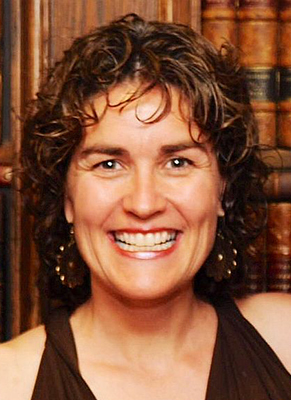
Mary Sirna
Sirna joined the department of public safety in January 2013. In her current role, she is a member of the investigative and threat assessment teams and manages the Story County Sexual Assault Team, for which Iowa State is a partner agency. Prior to that, she served as first assistant county attorney in the Story County attorney's office.
She succeeds Carl Wells, who left Iowa State last week to become the associate dean for campus life at Newberry College in Newberry, South Carolina. A national search for a permanent successor to Wells will begin in the coming months.
Sirna earned a bachelor's degree in political science and theatre arts from Mount Holyoke College, South Hadley, Massachusetts, and a law degree from the University of Iowa.
The Office of Equal Opportunity oversees compliance across the university for equal opportunity, civil rights, Title IX and affirmative action laws, regulations and policies. The office is charged with safeguarding a fair and respectful learning and working environment for students, faculty and staff. It includes coordinating the university's compliance with Title IX, Title VI, Title VII and the Americans with Disabilities Act.
Mental health training, help options are still growing
Significant faculty and staff enrollment in the RESPOND training this summer illustrates the campus community's growing commitment to better mental health. The eight-hour course provides an overview of symptoms associated with mental health problems and offers an action plan for participants when they see someone in need of help. Participants learn effective listening skills and how to ask important questions.
New program
This is the final summer student counseling services will offer RESPOND training. Beginning this fall, mental health first aid training will replace it. The new full-day training is evidence-based and updated regularly. Staff members across campus and members of the ISU police department are certified to conduct the training. Training sessions for faculty and staff will be scheduled during winter break and summer session. Departments and units (up to 30 people) interested in training prior to those times can contact the ISU police department.
This summer was the first time an additional training -- which has been conducted for seven years and can accommodate 45 people at each session -- was added to meet the demand.
"The training involves instruction and interactive components that allow us to role play and ask the hard questions about suicide," said Michelle Roling, student counseling services outreach director.
Roling said it is important faculty and staff recognize the signs of someone in distress and know how to connect them with assistance because 1,100 college students die by suicide yearly in the U.S.
"Of those that died by suicide, 86% never reached out for official services through their campus counseling center," Roling said. "We are really dependent on our colleagues to be vigilant, know the signs and symptoms, and especially know how to connect or refer someone to the appropriate services on campus."
Roling said training like Question, Persuade and Refer, which is offered every other week during the academic year, and RESPOND are like CPR training. It prepares faculty and staff for a lifesaving moment, but the intent is not that one person provides all the help. Trainings also help people look closer at their families or themselves to ensure they are getting care.
Helping hand
Student wellness director Brian Vanderheyden said faculty and staff understand mental health is one of students' biggest challenges because they see it in the classroom and in their work.
"Every year I have been here, staff and faculty awareness continues to go up and, because of that, it leads to more skill development, conversations, education and how they connect students to resources," he said.
Vanderheyden said the increased interest in trainings like RESPOND reflects the fact that faculty and staff find themselves in a first responder role to help students. Students in distress typically turn to someone they trust first, like an instructor or advisor, he said.
"These trainings really focus on people in high student-facing positions and the skills to help a student in distress get connected to support," Vanderheyden said. "These people are not counselors or mental health professionals, so the trainings help people know their roles and boundaries."
Vanderheyden will help ISU transition to a Jed campus -- named for the son of the founders of the foundation who killed himself in college -- as one of the 19 strategic plan projects funded during fiscal year 2024. The Jed Foundation helps colleges and universities develop strategic plans to enhance the mental health of students.
"It is a four-year program that will begin in August with a needs assessment and the goal of having a strategic plan by the end of the year," he said. "In years two and three, we implement, and in year four we work on our evaluation and sustainability plans to continue in the future."
One community
Senior WorkLife and WellBeing coordinator Stephanie Downs said she has seen an increased awareness of mental health at all levels of ISU in recent years. She said she has experienced a significant increase in requests across campus to talk about self-care options, especially around burnout. Downs takes into consideration the person's life -- both at work and home -- when speaking to groups.
"Going through trainings like RESPOND or mental health first aid really helps prepare people for those conversations," she said. "Leadership at the university, from managers and supervisors on up, also has increased awareness around mental health."
ISU has not seen a significant spike in mental health issues, but it continues to outpace claims in other areas since the pandemic began, said university human resources director of benefits Ed Holland. Helping people identify and deal with issues combats insurance costs for medical and pharmaceutical needs.
More help
ISU has numerous programs that help employees deal with mental health issues. The Employee Assistance Program offers free counseling, life coaching, financial and legal consultations, elder care and child resources, and more. Therapy Assistance Online is an online library of interactive programs that help people learn life skills and bounce back from disappointments and stumbling blocks. There also are numerous Workday Learning trainings available, and ISU WellBeing provides tools that can help employees deal with issues ranging from financial to child care.
"There are different ways we are trying to help because not everyone is stressed about the same type of thing," Holland said.
Sliding into electric: CyRide adds two buses
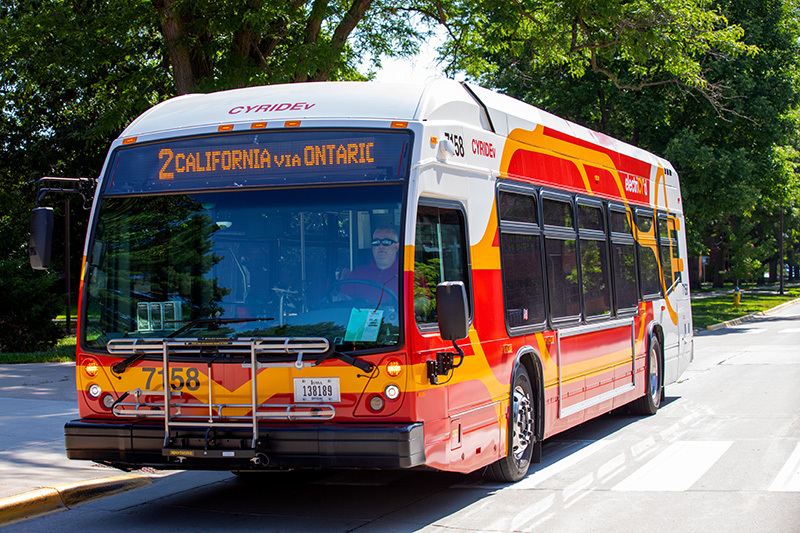
One of CyRide’s new electric buses moves along the Green route on Osborn Drive on campus last month. Photos by Christopher Gannon.
The CyRide fleet received a jolt this summer with the addition of two electric buses.
Built by Nova Bus, the manufacturer of CyRide's articulated buses, the long-range distance, 40-foot buses can cover a daily route on a single charge. There are two recharging stations housed indoors at CyRide where the buses are plugged in and require about four hours to fully recharge. Every CyRide driver will be trained on the new buses, which have a training hours requirement to operate, just like the articulated models.
"Overall, I don't think riders will notice a difference between them and our regular fleet," said Christine Crippen, assistant director for operations. "The electric buses have the same design and hold the same number of passengers, but they do lean a little bit more when going through roundabouts and other tighter turns."
The batteries are stored at the top of the bus, contributing an additional 7,000 pounds of weight compared to a 29,000-pound diesel bus. The batteries charge whenever the brake is applied or a bus is not moving.
The electric buses will run on the Plum and Green routes because both pass by the CyRide garage. Crippen said it will take at least a year in use to understand their capabilities and limitations. For example, severe weather -- both heat and cold common in the Midwest -- may impact bus efficiency and battery life.
Each bus had a price tag of just under $1 million, funded by CyRide's three financial partners: the city of Ames, Iowa State University administration and Iowa State students through a student fee. They arrived in Ames in May and since then, CyRide staff completed several tests and installed additional locators and cameras.
Fully electric?
The city has tried to add electric buses since 2019, but a combination of demand, supply chain issues and the pandemic-delayed delivery slowed arrival. Crippen said additional electric buses are in future budgets, but continued supply chain issues are anticipated to drive costs above $1 million per bus.
City staff worked with a consulting firm to determine the best use of electric buses in Ames.
"They came in and studied what the infrastructure could support, and their recommendation was 17 electric buses," Crippen said.
CyRide currently has about 100 buses that service its routes. To go fully electric and cover the same routes, nearly 300 electric buses would be required to account for recharging demands. In addition, Crippen said, the CyRide facility would need an electrical remodel to accommodate all that battery charging.
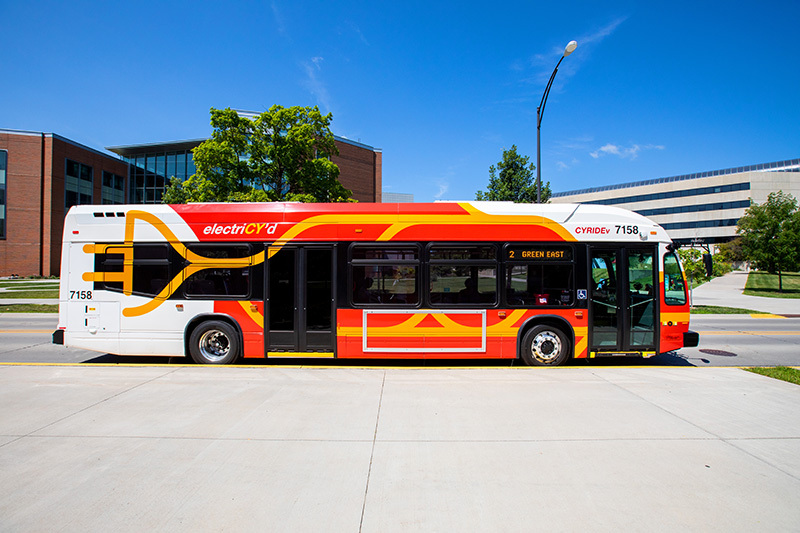
The electric buses run on the Plum and Green routes because both pass by the CyRide garage.
Wind turbine will come down next week
After more than a decade in service, the wind turbine in the northeast corner of campus between the university power plant and CyRide facility will be removed next week. Demolition is slated to conclude by Thursday, Aug. 10. The 160-foot, 100-kilowatt turbine became increasingly unreliable in recent years before it stopped operating last August.
Purchase or produce
Mark Kruse, director of utility services, said the turbine produced approximately 0.055% of the electricity used on campus, and the revenue it generated for the owner -- an average of $9,000 worth of electricity annually -- was unlikely to keep up with the cost of repairs.
Repair costs weren't the only concern. Iowa State's 10-year power purchase agreement (PPA) with Ohio-based SUREnergy, which owns the turbine, required the university to pay 10 cents per kilowatt for electricity generated by the turbine. The current purchasing cost for renewable electricity from an energy provider averages between 4 and 4.5 cents per kilowatt.
Did you know?
Iowa State is ranked among the top 30 colleges and universities in the Environmental Protection Agency's Green Power Partnership.
Kruse said Iowa State purchases renewable electricity off the grid as well as the renewable energy credits associated with its production. At first, producing the energy in-house may seem like the better option, but Kruse said purchasing renewable electricity helps facilities planning and management (FPM) continue to meet and expand the university's sustainability goals at a fraction of the cost.
"We need to be good environmental and financial stewards for our students," Kruse added. "Purchasing renewable energy also encourages energy providers to produce more renewable energy and replace non-renewable sources."
Purpose fulfilled
As the turbine aged, finding opportunities to use it as a learning tool -- once an added benefit for students and researchers studying energy -- also became difficult. Kruse said FPM maintains data collected from the turbine and would share it with visitors during plant tours, but its technology and information became outdated in comparison to new generations of turbine technology.
Though the turbine has reached the end of its lifespan, Kruse felt it was still an important milestone in the university's ongoing transition to using more renewable energy and decarbonizing the campus.
"We've been able to acquire firsthand wind production data -- information that aids progress toward a carbon-neutral campus," he said. "The wind turbine no longer will be a part of Iowa State's sustainability portfolio, but with the assistance of a national renewable energy consultant, other forms of alternative energy are being studied for campus application and financial feasibility."
Sharing Jack Trice's legacy with Iowans at the state fair
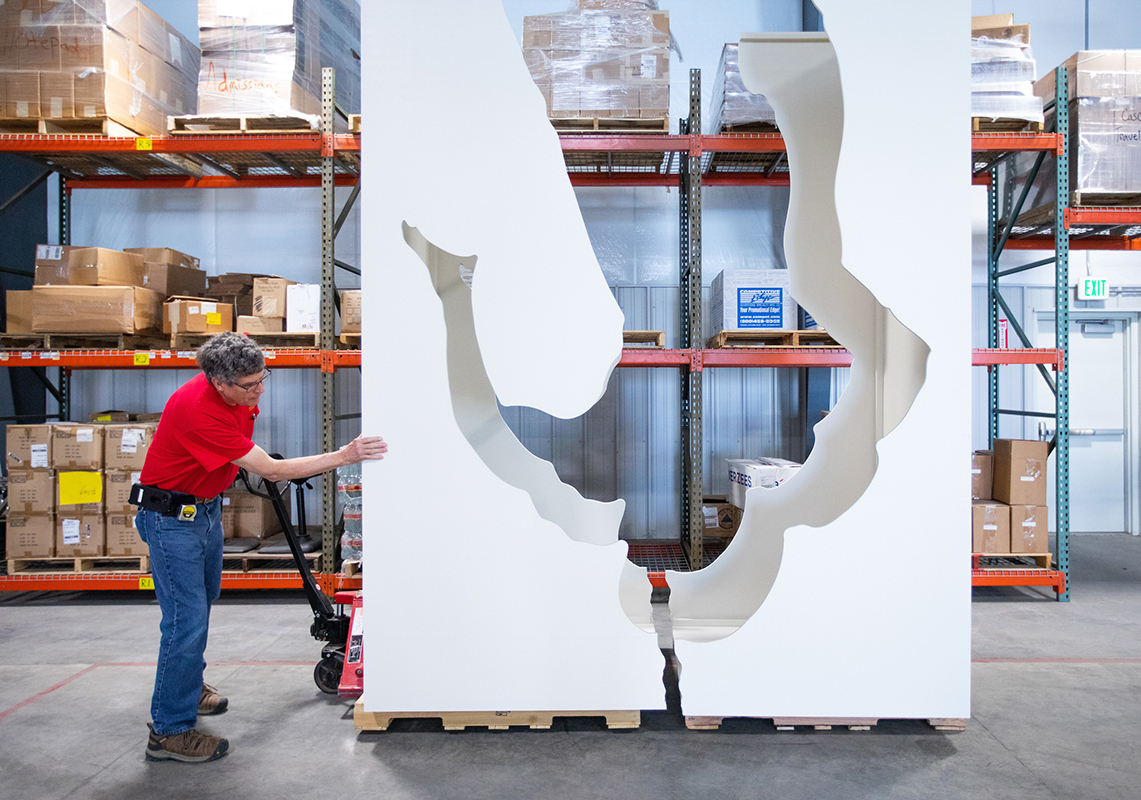
Former ISU carpenter Randy Fiscus, who retired from facilities planning and management (FPM) May 1, moves one of his final work projects into short-term storage last April: A wood scaled replica of artist Ivan Toth Depeña's Breaking Barriers sculpture installed last fall north of Jack Trice Stadium. Fiscus constructed the model's two pieces, staff in the College of Engineering used their waterjet to cut out the Jack Trice figure and FPM painters painted, inside and out. The 11-foot tall model will be part of the university's exhibit at the Iowa State Fair Aug. 10-20. Photos by Christopher Gannon.
The story of Jack Trice will take center stage at Iowa State's exhibit at the 2023 Iowa State Fair.
Titled "Breaking Barriers: The Story of Jack Trice," the exhibit highlights the life and legacy of Iowa State's first Black athlete, as part of the university's commemoration of the 100th anniversary of Trice's death due to injuries suffered during a football game at the University of Minnesota. The exhibit will be open to fairgoers in the Varied Industries Building from 9 a.m. to 8 p.m. every day of the fair, Aug. 10-20.
In addition to the Jack Trice exhibit, Iowa State's reach will extend across the fairgrounds in a multitude of 4-H events and veterinary care for all fair animals provided by the College of Veterinary Medicine.
Breaking Barriers: Jack Trice's story
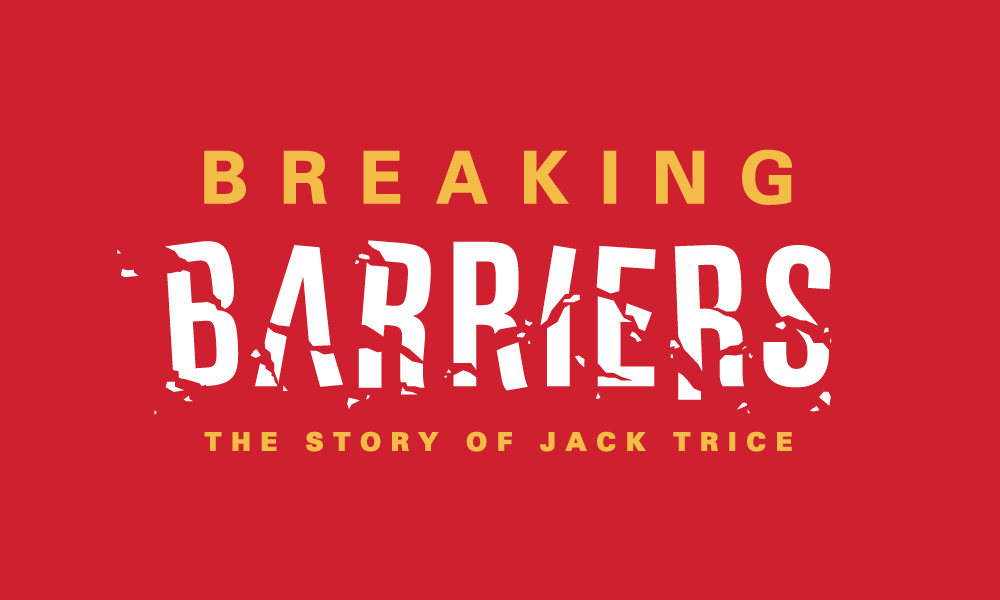
Fairgoers who visit the Iowa State exhibit will be able to walk through an 11-foot-tall scale wood model of the "Breaking Barriers" sculpture honoring Trice and unveiled in the Albaugh Family Plaza just outside Jack Trice Stadium last fall. The fair exhibit also will feature archival displays of Jack Trice's "I Will" letter, which Trice wrote the night before his final game, alongside communications from his wife and mother.
Visitors to the exhibit will learn about the history of naming the university's football stadium in his honor and get an up-close look at the throwback uniforms to be worn by the Cyclone football team for the Jack Trice Legacy Game on Oct. 7 against Texas Christian University. The uniforms incorporate design elements that call back to the uniforms worn by Trice and his teammates during the 1923 season. Visitors to the exhibit can post photos on social media for a chance to win two free tickets to the Jack Trice Legacy Game, and kids can have their picture taken in a cutout featuring the throwback uniforms.
The exhibit also will include photographs of three art installations depicting Jack Trice on campus taken by Des Moines photographer King Au.
"With this year's fair exhibit, we want to educate people about Jack Trice's enduring legacy as an athlete, as a student and as a man," said Carole Custer, director of university marketing. "His story is a cornerstone of Iowa State University's culture that continues to inspire conversations about race, character and commitment. We invite the hundreds of thousands who will pass through the Varied Industries Building during the Iowa State Fair to experience that important legacy."
Meet Cy, shop for gear
Cy, Iowa State's iconic mascot, will appear at the university's exhibit between 11 a.m. and 1 p.m. on Aug. 11-13 and Aug. 18-20. Visitors to the exhibit can pick up Cyclone football posters and schedule cards and receive free waterless temporary tattoos featuring the 5-Bar logo design. The University Book Store will offer a variety of Cyclone merchandise, gifts and apparel for sale in the exhibit. Athletics trophies, including the CyHawk trophies, will be on display for visitors as well.
4-H at the fair
Look for 4-H youth activities and displays each day in the Bruce L. Rastetter 4-H Exhibits Building. Headquartered at Iowa State and available in all 99 counties, 4-H emphasizes hands-on learning in agriculture and natural resources, leadership and civic engagement, communication and the arts, healthy living, and STEM (science, technology, engineering and mathematics). From livestock shows to a runway fashion show to educational presentations, 4-H will host multiple activities each day of the fair. A full schedule of 4-H youth programming at the fair is available online.
Veterinary care at the fair depends on Iowa State
Many of the Iowa State Fair's most iconic and longstanding traditions involve animals. Overseeing their health and wellbeing takes a small army of clinicians and students from the College of Veterinary Medicine. This year, the veterinary clinicians include Rachel Friedrich, Megan Hindman, Mitch Hiscocks, Lynn Geoffroy, Cody Sacquitne, Allison Vander Plaats, Caleb Brezina and Michelle Buckley, as well as fourth-year veterinary students Austin Lange, Alex Bishop, McKenna Brinning and Ali Stadtlander.
Iowa State veterinarians and veterinary students also will help with the farrowing display at the state fair. They include Gabi Doughan, post-doctoral research associate; Justin Brown, assistant teaching professor; Locke Karriker, director of the Swine Medicine Education Center; Kristin Skoland, program coordinator with the Swine Medicine Education Center; Becca Walthart, master's student; Cora Schau, veterinary intern; Grace Clark, veterinary intern; Justin Hennessey, veterinary student; and Meredith Petersen, post-doctoral research associate.
Other appearances by Iowa Staters include:
- Dave Gieseke, communications director for the college, will be a featured speaker at Vet Camp Aug. 10-13, a hands-on program for students in grades 4-7 to learn about animal health and welfare.
- Dan Grooms, the Stephen G. Juelsgaard Dean of Veterinary Medicine, will show a steer named Chunky Monkey and raised by Leah Bean of Marathon at the Governor's Charity Steer Show on Saturday afternoon, Aug. 12.
- Dairy Science Club students will host the annual "I Milked A Cow" program at the fair (daily 9-11 a.m., 1-3 p.m., 4-6 p.m., Cattle Barn), a fundraiser for the club. Club members lead a parlor talk on dairy production, and for $3, visitors can learn how to milk a cow by hand. And they can observe how modern milking equipment works in the milking parlor directly across from the Livestock Pavilion.
